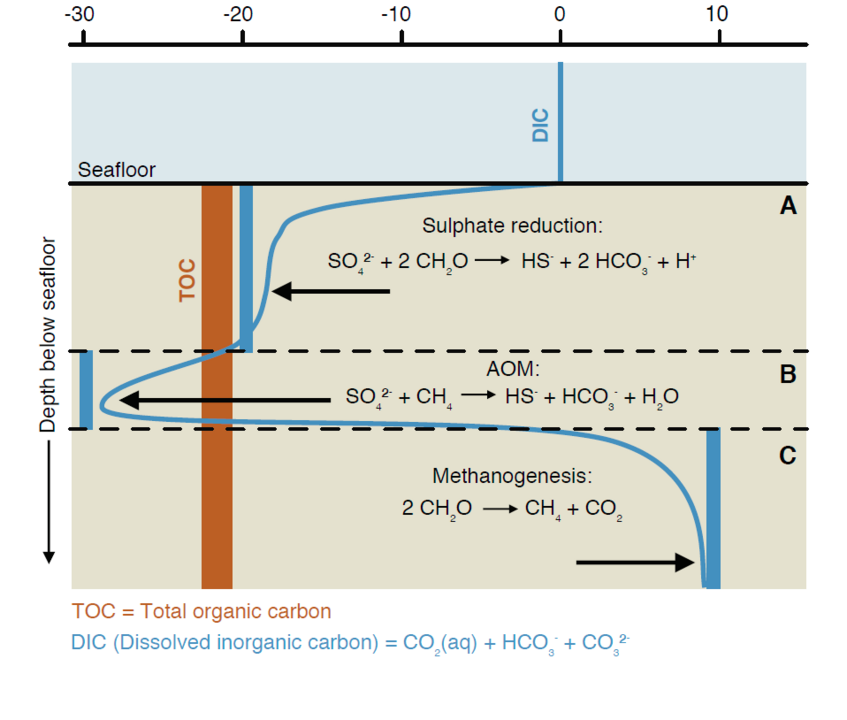News
Simulating porewater chemistry in marine sediments
Patrick Meister and his colleagues published a numerical model study in Frontiers in Earth Science, reproducing the full chemical speciation in marine porewater through a 230-m-thick sedimentary sequence drilled in the Peru-Chile Trench. The model shows how microbial metabolism, mineral reactions, and diffusive transport, result in high alkalinity within a zone of intense methane generation. This contributes to prevent acidification by CO2 and supports the formation and burial of diagenetic carbonates.
Reproducing porewater profiles over millions of years
The model code written in C++ links the reaction and transport of more than 90 chemical species to Phreeqc, an open-source aqueous-speciation program available from the U.S. geological survey. The model is now applicable to many sites in the world’s oceans, wherever porewater chemistry has been measured. Being able to simulate the evolution of porewater chemistry, including the state of the carbonate system, throughout a depth profile over millions of years is a requirement for correctly predicting carbonate diagenesis, transport of gas phases, alkalinity fluxes to the water column, and many other effects of marine porewater chemistry.
How the deep biosphere interacts with global biogeochemical cycles
While the presented model only represents a first step, the authors are convinced that the model will help to solve many problems in marine biogeochemistry. The model will allow us to reproduce the evolution of the deep biosphere over geological time and ultimately can help us to understand its effects on global biogeochemical cycles.
Meister, P., Herda, G., Petrishcheva, E., Gier, S., Dickens, G.R., Bauer, C. and Liu, B. (2022) Microbial alkalinity production and silicate alteration in methane charged marine sediments: implications for porewater chemistry and diagenetic carbonate formation. Frontiers in Earth Science 9, 756591, 1–18.
https://doi.org/10.3389/feart.2021.756591
Measured (solid symbols) and simulated porewater concentration profiles (lines) vs. depth at Ocean Drilling Program Site 1230, drilled in the Peru-Chile trench: (A) sulphate and methane; (B) ammonium; (C) inorganic carbon species; (D) pH (dashed line: after equilibration with headspace); (E) dissolved inorganic carbon and total alkalinity; (F) Ca and Mg; (G) K, Na, and Cl; and (H) total Si. All concentrations are reported in mmol/L. Dotted lines: simulation including microbial reactions; solid lines: simulation including microbial and mineral reactions. Measured data are from D’Hondt et al. (2003) and Donohue et al. (2006). For details see Meister et al. (2022).
Sebastian Viehmann (Dept. of Geology) and his colleague Simon V. Hohl (Tongji University, Shanghai, China) recently published the paper “Stromatolites as geochemical archives to reconstruct microbial habitats through deep time: Potential and pitfalls of novel radiogenic and stable isotope systems” in Earth Science Reviews (https://doi.org/10.1016/j.earscirev.2021.103683).
Stromatolites, i.e., lithified microbial mats, occur in the rock record from at least 3.4 billion years ago (e.g., at the Strelley Pool Formation in the Pilbara Craton, Australia, Fig. 1) until today (e.g., at Shark Bay, Australia, Fig.2) and provide high resolution snapshots into microbial habitats through deep time. With the methodological and analytical improvements of the last decades, new isotope proxies emerged and found their way into stromatolite research. Although most isotope proxies are far away from fully understood to date, radiogenic isotope systems are used to directly date stromatolites and determine the source of elements in ancient (sea)water, while stable isotopes are used to better understand redox conditions, metal availability, and (biogenic) metal cycling processes in microbial habitats.
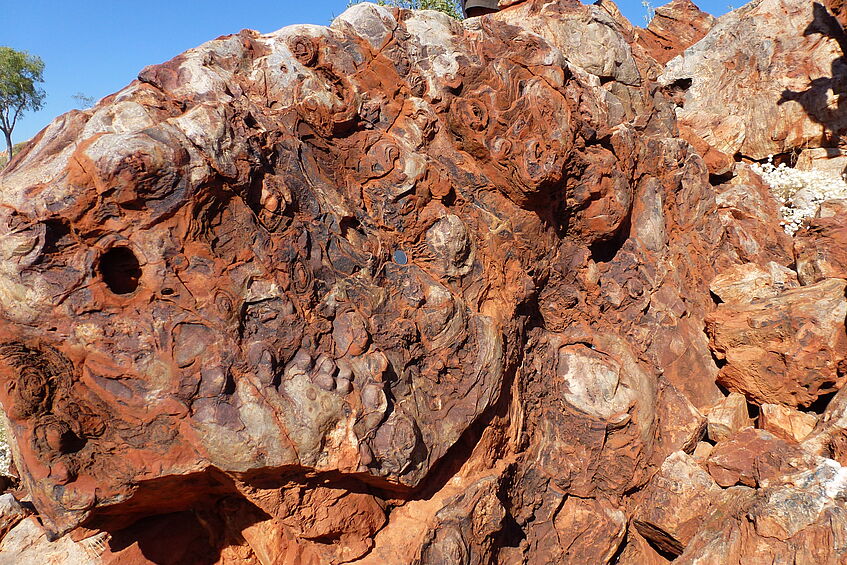
Strelley Pool Formation in the Pilbara Craton, Australia, Fig. 1 (© S. Viehmann)
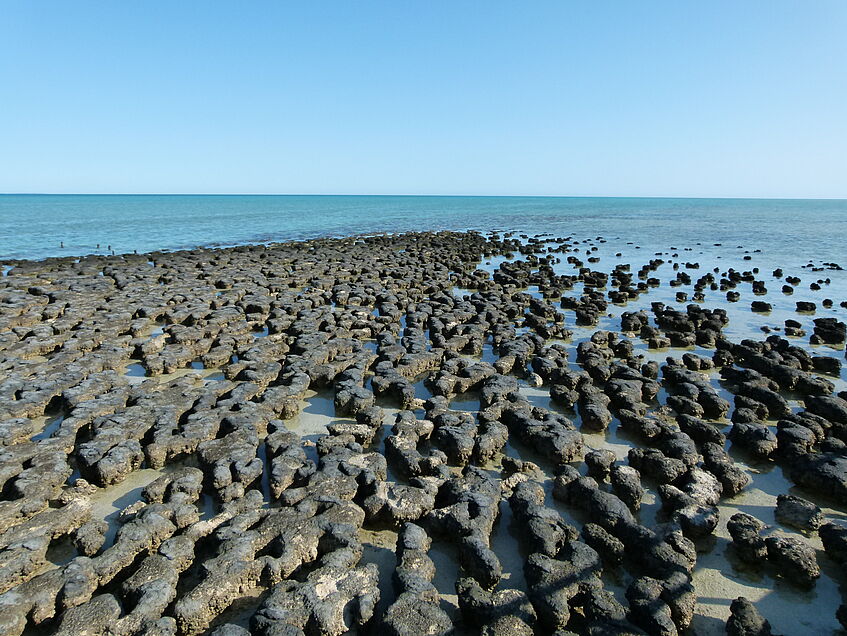
Shark Bay, Australia, Fig.2 (© S. Viehmann)
Sebastian Viehmann and his colleague provide a comprehensive review about the applications of novel, emerging, and established stable (O, C-N-S, Fe, Mo, Cr, U, Cd) and radiogenic (U-Pb, Rb-Sr, Sm-Nd) isotope applications to stromatolites, point out the potential and pitfalls of each isotope system and provide a future perspective on isotope applications for stromatolites.
In the recent volume of Geology (March, Volume 49/3, 2021) there are two papers of the Department of Geology published.
The first paper (Le Heron, Busfield, Kettler: Ice-rafted dropstones in “postglacial” Cryogenian cap carbonates) investigates dropstones from Namibia and concludes that evidence for vestigial glaciation concomitant with cap carbonate deposition merits a reappraisal of the depositional conditions of cap carbonates and their paleoclimatic significance.
The second paper (Fernandez, Habermüller, Grasemann: Hooked on salt: Rethinking Alpine tectonics in Hallstatt (Eastern Alps, Austria)) demonstrated that spectacular halokinetic sequences in Triassic platform carbonates suggest that the Hallstatt diapir grew passively during the Triassic, surrounded by carbonate platforms, and extruded to the seabed during the Jurassic.
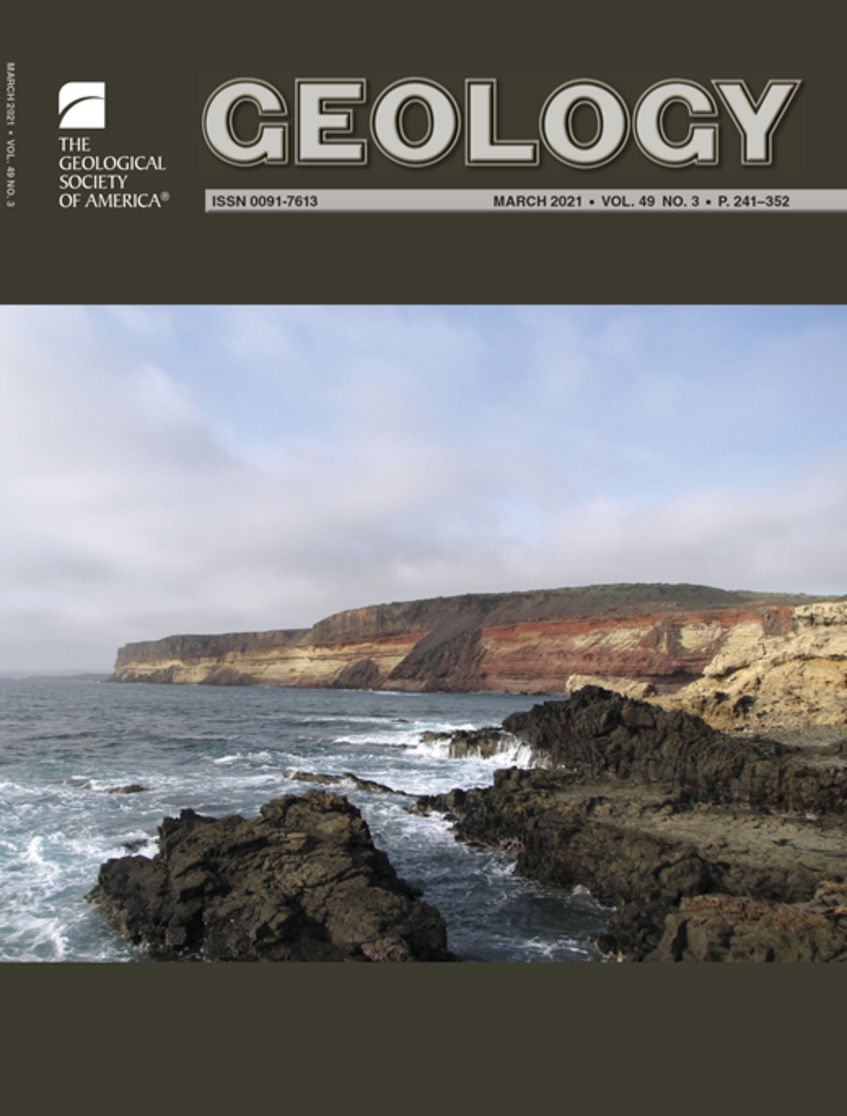
Geology (March, Volume 49/3, 2021)
Presentation
Further reading to the talk of Dr. Holger Paulick within the framework of our Earth Sciences Colloquium on January 14th, 2021.
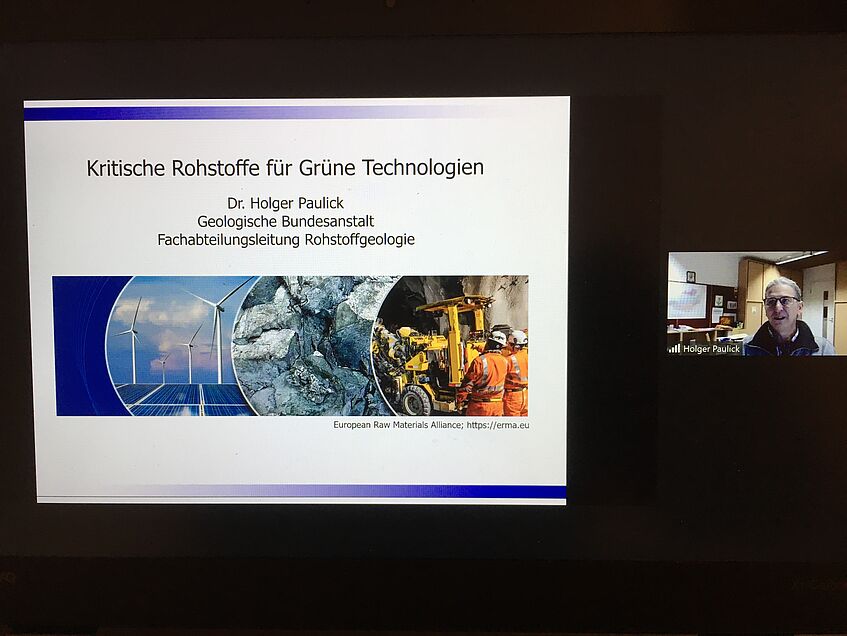
© M. Wagreich
New blogpost of the EGU
Dating mineral phases in geological remnants of early life
Blogpost written by Sebastian Viehmann (blog of the Biogeosciences Division of the European Geosciences Union)
https://blogs.egu.eu/divisions/bg/2020/05/21/dating-mineral-phases-in-geological-remnants-of-early-life/
PDF: Dating mineral phases in geological remnants of early life
Original article: https://www.sciencedirect.com/...
Cretaceous Climate Events and Short-Term Sea-Level Changes
The final Proceedings Volume of UNESCO-IGCP 609 has been published and printed. It is entitled "Cretaceous Climate Events and Short-Term Sea-Level Changes", edited by Michael Wagreich, Malcolm Hart (Plymouth), Benjamin Sames, and Ismail O. Yilmaz (Ankara) and has been published as Volume 498 of the Geological Society, London, Special Publications. The volume comprises an Introduction/Overview (open access) and 11 articles, including two review papers (one open access) and a set of case studies.
Sea level constitutes a critical planetary boundary for geological processes and human life. Sea-level fluctuations during major greenhouse phases are still enigmatic and strongly discussed in terms of changing climate systems. The geological record of the Cretaceous greenhouse period provides a deep-time view on greenhouse-phase Earth System processes that facilitates a much better understanding of the causes and consequences of global, geologically short-term, sea-level changes. Especially Cretaceous hothouse periods can serve as laboratory to better understand a near-future greenhouse Earth. This volume presents high-resolution sea-level records from globally distributed sedimentary archives of the Cretaceous involving a large group of scientists from the International Geoscience Programme IGCP 609. Marine to non-marine sedimentary successions were analysed for revised age constraints, correlation of global palaeoclimate shifts and sea-level changes, tested for climate-driven cyclicities,and correlated within a high-resolution stratigraphic framework of the Geological Timescale. For hothouse periods, the hypothesis of significant global groundwater-related sea-level change, i.e. aquifer-eustasy as major process, is reviewed and substantiated.
Link: sp.lyellcollection.org/content/498/1
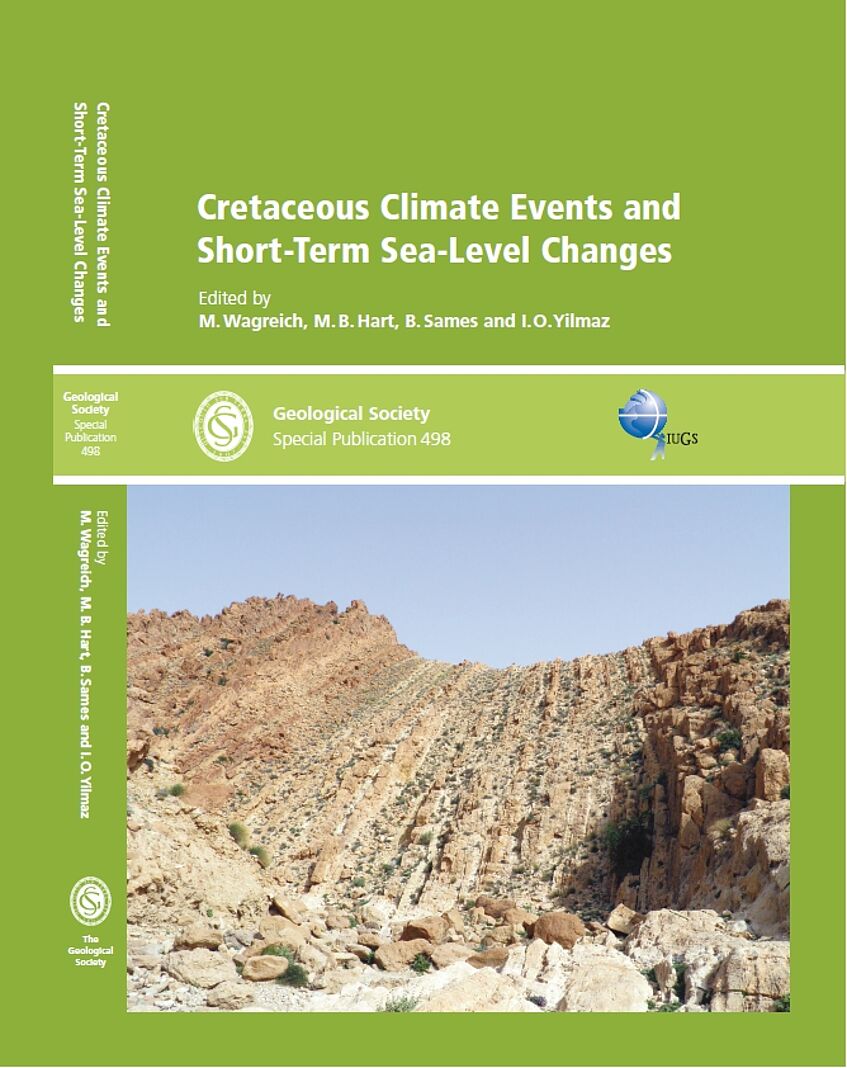
Object of the Month (The Collections at Vienna University)
The new Object of the Month April 2020 is from the Geological Archive of the Department of Geology:
(Link: https://bibliothek.univie.ac.at/...)
The geologic overview map of the Eastern Alps by Leopold Kober is a preliminary version of his view of the tectonic architecture of the Alps and the Dinarides, which was strongly influenced by the early ideas of nappe tectonics.
A strongly modified version of this map was later published in KOBER, L. (1938). Der Geologische Aufbau Österreichs. Wien, Julius Springer: 204 pp.
Best Paper Award in "Geosciences"
The review paper by Meister and Reyes (2019) on "The carbon-isotope record of the sub-seafloor biosphere" received the MDPI Geosciences best-paper award.
This interdisciplinary review paper summarizes the processes that lead to the formation of carbon isotope archives of past sub-seafloor biospheres. The paper demonstrates that these records are the result of a range of different factors, including isotope effects of microbial biochemical pathways, porefluid chemistry, transport processes, and diagenetic carbonate precipitation.
Variations in carbon isotope signatures are found preserved in diagenetic carbonate records, documenting that microbial activity below the seafloor is not static, but changed over time in response to environmental conditions at the Earth’s surface.
Meister, P. and Reyes, C. (2019) The carbon-isotope record of the sub-seafloor biosphere. In: "Tracking the Deep Biosphere through Time" (Eds. H. Drake, M. Ivarsson, C. Heim), Geosciences 9, 507, 1-25. https://doi:10.3390/geosciences9120507
New book from the Department of Geodynamics and Sedimentology
Dan Le Heron and colleagues have just published a new book entitled "Glaciated Margins: the Sedimentary and Geophysical Archive" under the flagship Special Publications series of the Geological Society of London.
This book arose out of a major international conference in 2016 held in Burlington House, London, and brings together contributions from deep time (Cryogenian, Ordovician, Carboniferous-Permian) and more recent (Pleistocene, Modern) in one tome, exploring the general traits of glaciated margins, including rifted margins where the signal of the glacial record becomes somewhat diluted. Collectively surveying marine geophysical datasets through to outcrop data, the broad scope of the book showcases the exciting aspects of Glaciated Margins Science across geological time.
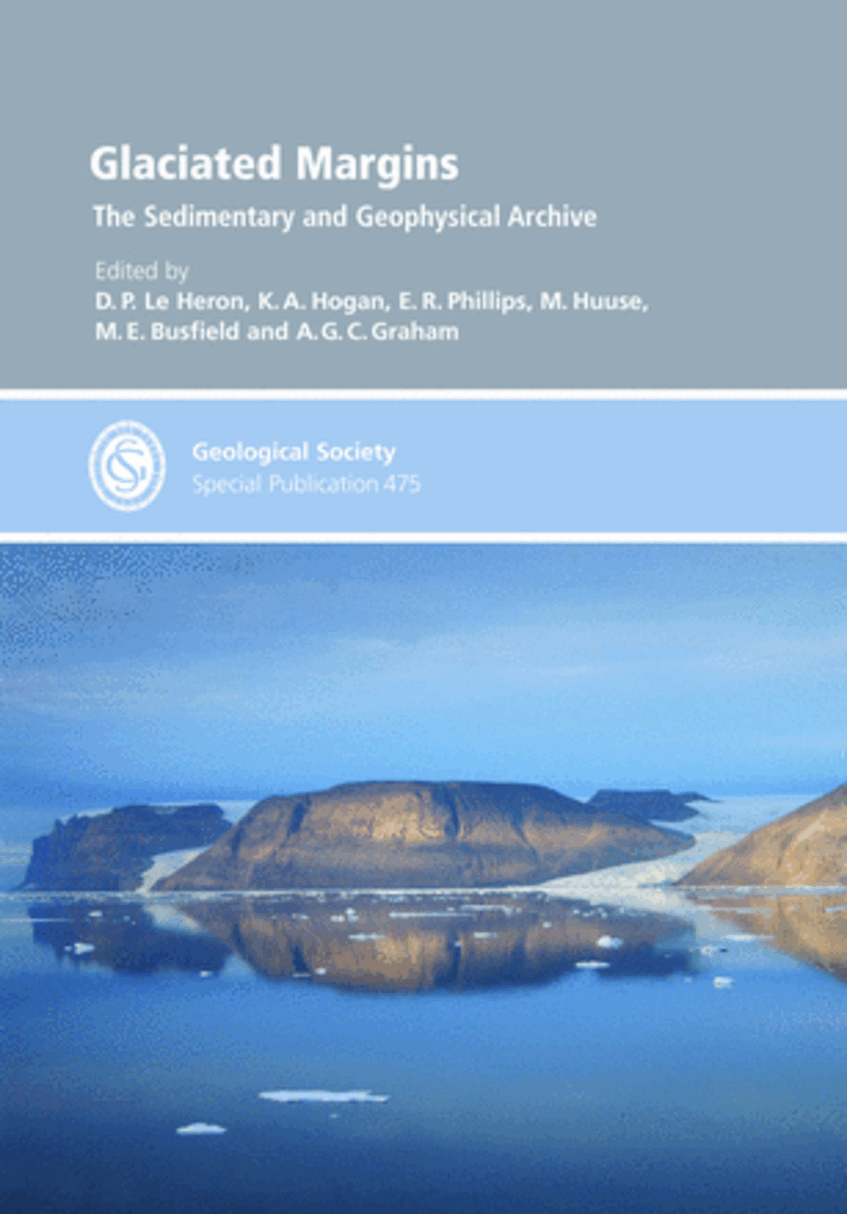
New Article
Le Heron, D.P. and Vandyk, T.M. 2019. A Slippery Slope or Cryogenian Diamictites? The Depositional Record, DOI: 10.1002/dep2.67
How "glacial" really are ancient glacial deposits? Building on previous work that the published recently in Geology, Le Heron and Vandyk show that some of the famous, so-called "glacial" deposits of Death Valley, though to belong to the Marinoan (younger Cryogenian, ca. 650 Ma) global glaciation are unrelated to glaciation at all.
The study substantiates previous work by the likes of Jessica Creveling and colleagues, who emphasised the importance of platform instability and slope collapse. It really is important to not assume that diamictites- jumbled up deposits with large blocks and boulders inside- are glacial, without looking carefully first!


